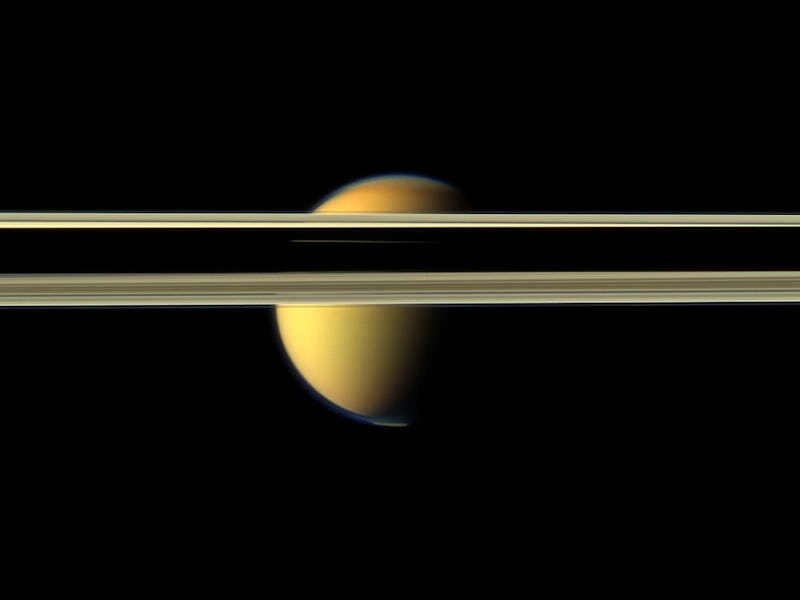What a strange experiment reveals about one of the likeliest places for life outside Earth
Scientists recreated pieces of Titan in glass cylinders.

Titan may be about a billion miles away from Earth, but a group of scientists just recreated the ingredients for Saturn’s largest moon in a lab.
As the only other place besides Earth known to have present-day rivers, lakes, and seas, Titan serves as the perfect landscape to study life in the universe. But on Titan, any life that would’ve developed would look vastly different than Earth’s as the moon’s bodies of water are made up of methane and ethane.
Scientists recreated Titan’s conditions in tiny glass cylinders inside a lab to observe how life may have originated on such different terrain. The experiment revealed how two common Earthly organic molecules would behave differently on Titan, revealing the nature of possible lifeforms on that moon.
The researchers presented their findings at the fall meeting of the American Chemical Society (ACS), which was held virtually and in-person on August 22-26.
What’s new — To recreate an icy, extreme moon in a lab, first you start with water:
Titan is larger than the planet Mercury, measuring at 3,200 miles across.
- The temperatures on Titan drop down to a chilling -179 degrees Celsius, so the researchers lowered the temperatures in the experiment, freezing the water to mimic the icy bedrock of Titan
- Then they added ethane — a colorless, odorless gas, and the main ingredient of natural gas, which makes up the lakes of Titan
- Nitrogen is then added to the mix, the main component of Titan’s atmosphere
- To top off the moon’s recipe, the researchers finally added acetonitrile (ACN) and propionitrile (PCN)
ACN and PCN are organic molecules found in liquid form on Earth. But on Titan, ACN and PCN are found as icy, solid mineral crystals due to the satellite's freezing temperatures. They start out in the yellow, thick, hazy atmosphere of Titan as aerosols before raining down to the surface and freezing.
With all of Titan’s ingredients in the glass cylinders, the researchers raised and lowered the temperatures slightly to simulate the moon’s temperature changes.
In Titan's upper atmosphere, methane molecules are being broken apart by the Sun’s light and the byproducts combine to form compounds like ethane and acetylene.
“Our research revealed a lot about the structures of planetary ices that was previously unknown,” Tomče Runčevski, a chemistry professor at the Southern Methodist University, and lead author behind the new study, said in a statement.
By observing how the crystals behave under Titan’s conditions, the researchers were able to identify certain characteristics of the moon itself.
“We found that one crystalline form of PCN does not expand uniformly along its three dimensions,” Runčevski said. “Titan goes through temperature swings, and if the thermal expansion of the crystals is not uniform in all directions, it may cause the moon’s surface to crack.”
HERE’S THE BACKGROUND — Out of the 150 known moons in the Solar System, Titan is by far the most planet-like, with a dense atmosphere made up of nitrogen, hydrocarbon lakes, and methane in its atmosphere. These factors make it one of the likeliest places to host life in our Solar System. Its seas extend hundreds of feet deep and stretch hundreds of miles wide.
Titan also has an ocean made up of liquid water buried beneath its thick crust.
Any life on Saturn’s moon would have a completely different chemical makeup than the one found on Earth. Titan thus presents an interesting glimpse at how life might evolve under different conditions and what that life may look like.
WHAT’S NEXT — Scientists gathered most of their information on Titan through NASA’s Cassini mission, which launched on October 15, 1997, and entered Saturn’s orbit on June 30, 2004.
The spacecraft flew by Titan just before diving into Saturn’s atmosphere to dramatically end in 2017.
But NASA is preparing a new mission dedicated solely to exploring the strange world of Titan. Dragonfly will send a rotorcraft lander to Titan in the mid-2030s to explore the moon’s surface, studying its atmosphere and surface to interrogate its intriguing chemistry.
Abstract: Titan, Saturn’s icy moon, is an ideal planetary body to study prebiotic chemistry, origins of life, and the potential habitability of an extraterrestrial environment. It features a nitrogen-based atmosphere, complex organic chemistry fueled by radiation from the sun and Saturn’s magnetosphere, ethane-based lakes on top of water-ice surface on the poles, organic dunes on the equator, and seasonal evaporation and precipitation of hydrocarbons in a process notably similar to Earth’s hydrological cycle. As part of NASA’s New Frontiers Mission, a rotorcraft named Dragonfly will be launched in 2027 and is expected to arrive on the surface of Titan in 2034. In light of the imminent Dragonfly mission, revisiting the fundamental chemistry of the smallest organic molecules that make up the surface of Titan is of utmost importance. Here, we present our findings derived from laboratory modeling of the composition and structure of putative Titanean minerals based on synchrotron and neutron diffraction and spectroscopic experiments, calorimetric measurements and theoretical calculations.
This article was originally published on